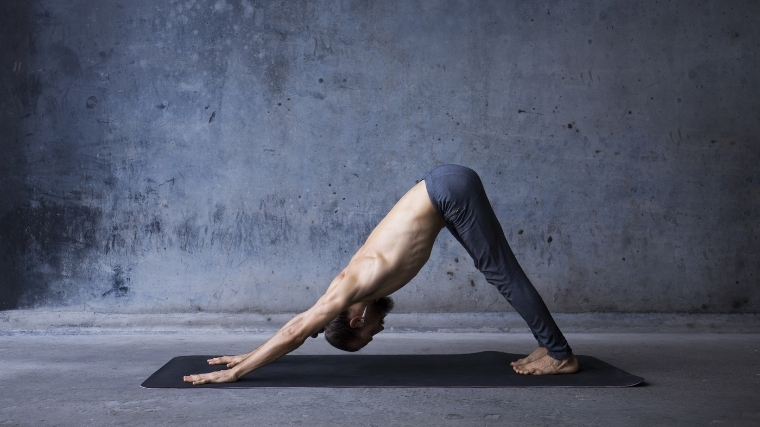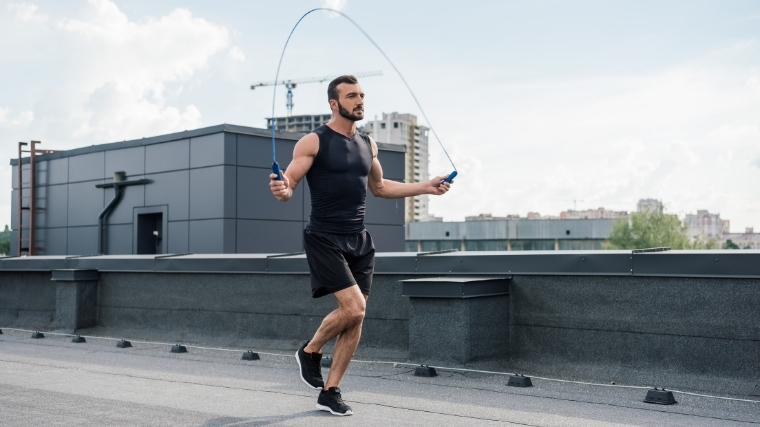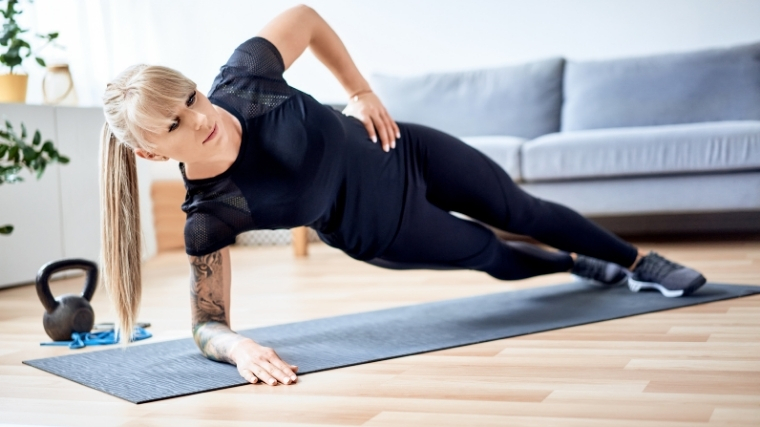Diving headfirst into your upper-body workout is a no-no. Throw on a couple of plates on the bench press, and your unprepared shoulder joints may be aching by the end of set one. For that reason alone, a good upper-body warm-up is a must before training. Other benefits include breaking a light sweat, enhancing blood flow, becoming mentally prepared, and improving your joint’s range of motion before the heavy lifting starts. Combined, all of these factors can help you prevent injury and have a more beneficial workout.
If you’re unsure of how or when to warm-up, that’s cool. Everyone starts somewhere, and right here happens to be a pretty good place to start. Below, we’ll go over the benefits of warming up your upper body and give you a routine to try.

Editor’s note: The content on BarBend is meant to be informative in nature, but it shouldn’t take the place of advice and/or supervision from a medical professional. The opinions and articles on this site are not intended for use as diagnosis, prevention, and/or treatment of health problems. Speak with your physician if you have any concerns.
Benefits of an Upper Body Warm-Up
If you want to lift your best, you’ve got to execute a solid warm-up in the best way possible. By warming up your upper body, you’ll activate all the muscles you’ll need to engage during your lifts. This is especially important for those smaller muscles like the rear delts, serratus anterior, and rhomboids that often get overshadowed by your bigger muscle groups — therefore making for less efficient lifts and making you more prone to injury.
Activate Under-Utilized Muscles
It’s not enough to battle your way through upper body pushes and pulls while only utilizing some of the tools in your arsenal. By specifically targeting your smaller back muscles for activation during dynamic upper body warm-ups, you’ll ensure that you’re maximizing your lift potential and minimizing your chance of injury during your lifting session.
Improve Blood Circulation
Improving blood circulation can help pump oxygen-rich blood to active muscle tissues, clear out any metabolic byproducts that may be causing some soreness within muscles, and improve overall circulation to working muscles.
Deliver More Oxygen to Working Muscles
The more oxygen-rich blood a muscle tissue has, the greater it can perform both anaerobic and active exercise. While upper body strength training is often anaerobic in nature, increased oxygen availability will help improve the body’s work capacity and improve recovery between working sets.
Restore and (Potentially) Improve Mobility
The goal of performing mobility and light stretching before a training session should be to maintain or gain mobility and movement. The key is not to perform the dynamic warm-up exercise, focusing on challenging “end range” mobility and movement. This can be highly exhausted and challenging on the muscle units.
Minimize Injury Risks
Performing a dynamic warm-up may potentially help to increase injury resistance due to lack of mobility and muscular readiness to perform more challenging movements — all of which could result in pulls, strains, and/or other common injuries that arise from improper warm-up routines.
Improve Focus
Increasing mental readiness is a large part of an athlete’s ability to train hard and stay focused throughout challenging workout sessions. A thorough dynamic warm-up allows an athlete to mentally prepare for the hard training session ahead to train psychologically.
When Should You Do a Dynamic Upper Body Warm Up?
Before your main workout. Depending on what strength sport you participate in — strongman, powerlifting, CrossFit, etc. — you may have a more or less involved pre-lift routine. Say static stretching, specific mobility moves, or neurological prep is on the docket, do your warm-up first. The goal is simply to improve bloody flow and concentration. You’ll notice that the moves listed below are simple, and that’s by design. Even if you need to cut your workout short, you can make time for a few of the exercises below. Then, get on with your normal routine.

Upper Body Warm-Up Basics
Before you dive into your dynamic upper body warm-up, it’s important to familiarize yourself with the basic principles of your movement prep routine. You don’t want to dive right into the more complex movement patterns. Still, you also don’t want to warm up, rest for a super long time, warm-up, and rest again for a super long time — remember that the goal is to get ready for your workout, not complete a set-rest-set-rest scheme like you will while lifting heavy. So keep your warmup flowing for the best results.
Keep Moving
Keep moving throughout your dynamic warm-up to help increase core body temperature and blood circulation. This will help to kickstart the metabolic processes that occur during your training session. Also, it will help you save time and work up a light sweat so you can go into your training session fully prepared to get after it.
Achieve a Full Range of Motion
The purpose of working the full range of motion before training is to help activate normal movement in the muscles, joints, and connective tissues. The goal here should not be to forcefully increase mobility and flexibility (as this can be demanding on the body before training) but rather to take what your body gives you in terms of movement.
After training sessions, you can then work to increase end range mobility and flexibility, as the muscles and connective tissues may be more receptive and pliable. In other words, don’t cheat yourself out of a good warm-up by only going through the motions without intention — but also don’t push yourself so hard that you’re starting your workout prematurely.
Progress Into More Explosive and Demanding Movements
As with most warm-ups, it is important to not jump into the most complex movements first, as the body has not been able to increase blood flow properly, elevate core temperature, and become neurological prepared for more challenging exercises (balance, stability, and ballistic movements). Start with slight movements that demand lower intensity levels to ease your body and mind into hard training sessions.
Upper Body Warm-Up
Here’s a warm-up you can do before any upper body lifting day. Do all the suggested sets and reps before moving on to the next exercise. Also, think of this as a foundation for you to build from and adjust. For example, if you are short on time, then pick a handful of moves from the list below — ideally cutting the similar ones — and performing a shortened warm-up. Or, if you want to break more of a set, do two to three rounds of the following moves as a circuit. As long as you abide by the guidelines above, you’ll be good to go.

Note: The full warm-up is listed below, but details — including the benefits and instructions — for each movement can be found below it.
- Jump Rope: 200 jumps (or three minutes of jumping)
- Arm Circles: 2 x 20 circles each direction
- Cat-Cow: 20 breaths (10 inhales and 10 exhales)
- Scapular Slides: 2 x 15 reps
- Side-Lying Thoracic Openers: 10 reps on each side
- Yoga Push-Up: 10 reps
- Side Plank: 30 to 45 seconds each side
- Scapular Push-Up: 2 x 20 reps (resting 20 seconds between sets)
- Shoulder Dislocates: 20 reps
- Band Pull-Apart: 20 reps
Jump Rope
- Get your wrists gently moving and ready for serious upper body lifts.
- Activate your shoulders without putting any pressure on them.
- Warms up your entire body by elevating your heart rate and priming yourself for the full-body coordination you need for upper body training.
How to Jump Rope
Start with the ends of the jump rope in your hands — loosely enough to have relatively relaxed fingers, but not so loose that it will fly out of our grasp. Hold the handles between your thumbs and index finger as though you were resting your thumbs on the side of your index finger. Keep your shoulders relaxed, and your upper body movement minimal as you skip — the momentum of the rope should be coming from your wrists, not your shoulders or upper arms. Don’t forget to land softly on the balls of your feet each time.
Arm Circles
- Prepares your body to keep your core stable while activating your upper body.
- Wake up your shoulders, upper traps, triceps, and biceps.
How to Do Arm Circles
Raise your arms out to your sides, keeping a very soft bend in your elbows. Keep your shoulders soft and away from your ears. Imagine that your index fingers are laser pointers, and use your arms to draw small forward circles on the walls off to your sides. Make sure to keep it even in reverse, too. Start with small circles (about the size of a lacrosse ball) and gradually increase their size — by the end of your reps, you should be drawing circles about the size of a soccer ball.
Cat-Cow
- Activate your thoracic spine to prepare your back for movement.
- Connect your movement with your breath so that you’re ready to perform the bracing necessary for heavy upper body lifts.
- Engage your core holistically and tune your body into full-body coordination.
How to Do Cat-Cows
Start in tabletop position, with your hands underneath your shoulders and your knees under your hips. As you take a deep breath in, arch your back by pulling your belly button down toward the ground. Look up slightly toward the ceiling. If you want to deepen the movement, drive your palms toward your feet without moving your hands. On your exhale, push down through your hands and arch your back the opposite way, drawing your spine toward the ceiling and tucking your tailbone down toward the ground.
Scapular Slides
- Specifically activate your rhomboids and serratus anterior, which will help these relatively smaller muscles engage in your upper body lifts.
- Prep your traps for heavy movements.
- Develop shoulder mobility and coordination between your lower body and your shoulders.
How to Do Scapular Slides
Stand with your heels between three to six inches away from the wall — more distance is perfectly fine if your body shape requires it. Tuck your tailbone so that your low back is “reaching” toward the wall, touching flush against it if your body allows. Pull your head back, giving yourself a double chin, to touch the back of your head to the wall. Raise your arms with elbows bent at 90 degrees, trying to get both your elbows and the backs of your wrists against the wall. With slow, steady control — and maintaining contact with the wall — lift your arms straight up as though you were performing an overhead press. Slowly lower, again maintaining contact with the wall.
Side-Lying Thoracic Opener
- Encourages you to maintain stability through a rigid core while moving your thoracic spine.
- Activate your thoracic spine to promote mobility — preparing your body for horizontal and vertical pushes and pulls.
- Engage your chest muscles and encourage your body to feel the connection between your chest and your back.
How to Do the Side-Lying Thoracic Opener
Start by lying on your left side, with your left arm straight out to the side with your palm up. Keep a soft bend in your mostly-straight right arm. Fold your arms over each other, touching your right fingertips to your left fingertips. From there, trace a circle over your head, keeping your fingers on the floor if you can. End with your right arm stretched out to the right side, then trace your way back. Repeat on the opposite side.
Yoga Push-Up
- Challenge your upper body’s endurance by extending the time under tension.
- Encourage shoulder strength and stability with the transition to the down dog portion of the move.
- Activate your T-spine and facilitate thoracic mobility.
How to Do the Yoga Push-Up
Start in a regular push-up position and sink into a slow, controlled pushup. As you rise back up, push your hips back and tuck your tailbone back and behind you, engaging a stretch in your hamstrings. Keep your shoulders relaxed and away from your ears. The transition back into pushup position and repeat.
Side Plank
- Warm-up your upper body by engaging your shoulders and triceps in an off-balanced setting.
- Enhance your isometric full-body coordination.
- Activate your core and prep for core engagement with bracing for heavy lifts.
How to Do the Side Plank
From a pushup position, shift onto your right side with your forearm on the ground and your elbow directly under your shoulder. Keep your shoulder relaxed and away from your right ear. Stack your left foot on top of your right foot, or brace your left foot slightly in front of your right. Squeeze your glutes, quads, and core to keep your hips from sagging down toward the ground. Maintain this proud position — and breathe — until the desired time is up.
Scapular Push-Up
- Grease the groove of the mind-body connection needed to engage your lats and traps in pushing exercises properly.
- Target your serratus anterior for activation, which is often overlooked in favor of larger muscles.
- Improve shoulder mobility by promoting healthy scapular motion.
How to Do the Scapular Push-Up
Begin in a regular push-up position. You’re going to simulate a push-up without actually bending your elbows or lowering your body. Slowly squeeze your shoulder blades together and press your chest out toward the ground without moving the rest of your body — maintain a solid core. Reverse the motion by pressing your upper back toward the ceiling, again without moving the rest of your body. That’s one rep.
Shoulder Dislocates
- Enhance shoulder mobility to help prevent impingement during upper body lifting.
- Acclimates your shoulders to movement.
How to Do the Shoulder Dislocates
With your feet shoulder-width apart, stand with your PVC pipe or resistance band in front of you, with a double overhand grip. Straighten your elbows and bring your arms up, overhead, and behind you. Lower behind your back as far as feels comfortable (this range of motion will likely increase as you get used to the movement) and return to starting position. Squeeze your glutes and prevent your ribcage from flaring throughout the movement.
Band Pull-Apart
- Engage your smaller upper back muscles, which are often overlooked during your workout.
- Activate your upper back by pulling, which you’ll need during your upper body pushing exercises (not to mention during back squats and deadlifts).
How to Do the Band Pull-Apart
Hold the band in front of you with your hands at shoulder width, using a double overhand grip. Keep your shoulders relaxed and down away from your ears, squeeze your glutes, and brace your core to prevent your ribcage from flaring. Squeeze your shoulder blades together, pulling the band apart — leading with your rear delts rather than yanking with your arms. Return to starting position slowly and under control, then repeat.
More Warm-Up Tips
This upper-body warm-up is just one piece of the training puzzle. Here’s some more warm-up content from BarBend to check out.
- 4 Warm-Up exercises You’re Not Doing (But Should Be)
- The Best Way to Warm Up Before Lifting Weights
- 3 Efficient and Time-Saving Shoulder Warm-Ups
Featured image: Luna Vandoorne/Shutterstock